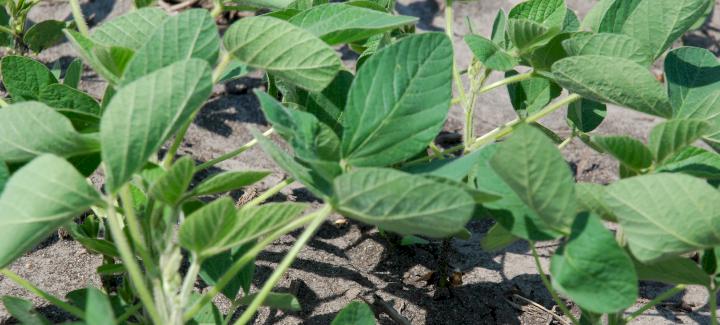
Corn and soybean diseases have been robbing yields across the country for decades. Several factors may encourage the development and spread of crop diseases, but remember that many are manageable and, in some cases, preventable if addressed early. Over the next two weeks, we’ll discuss the most common corn and soybean diseases, the conditions these diseases thrive in and the best management and prevention tactics to help control them. First up, common soybean diseases.
Common Soybean Diseases
Sunscald, also known as soybean “sunburn,” is environmental and will resolve if the soybean plant survives. Symptoms include rust-like spots on the bottom side of the leaf. The only yield risk here is related to drought.
Bacterial blight occurs in cool, wet weather and can be more prominent in fields where susceptible varieties are planted. Bacterial blight overwinters on plant residue, so tillage is recommended. Fungicide is not recommended to control this disease. Symptoms may include stunted plants, brown to dark red lesions with yellow-green halos surrounding each lesion.
Bacterial pustule thrives in hot, wet conditions. This disease is related to residue, and symptoms typically appear as lighter colored green spots that can have a blister effect on the leaves. Rotation and tillage are recommended to control bacterial pustule, but it is not recommended to apply a fungicide.
Brown spot, also known as Septoria leaf spot, does not pose a significant yield risk unless it’s found in the upper canopy and begins causing defoliation. This disease thrives in cool, wet weather. Rotation and tillage are recommended for management.
Brown stem rot occurs in cool, wet conditions and is residue related. This is more prominent in susceptible varieties and can cause difficulty with harvest and lodging. Crop rotation is the best treatment for brown stem rot. Symptoms can include browning of the stems and leaf tissue between the veins.
Cercospora occurs in hot, wet conditions, with symptoms appearing as tan to brown lesions with dark purple borders. The disease is residue and seed related. Tillage and seed treatments are recommended, but you should not keep cercospora-infected seed for future use.
Charcoal rot thrives in warm, dry conditions. You can keep plant stress low by planting moderate populations with a good fertility program. Adjusting your variety can help, as can residue management and crop rotation. Symptoms include brown streaks on the roots, with worsening conditions reaching the canopy, causing yellowing of the leaves and leaf drop.
Downy mildew occurs in cool, wet conditions but it is not a significant yield risk. Fungicides can be applied to help with cosmetics. Symptoms include small, tan, elevated spots on the bottom side of the leaf.
Frogeye leaf spot is a soil-borne disease that can lead to significant yield loss. Tillage is recommended, as well as some fungicides. This disease thrives in hot, wet conditions and can be detected by red to red-brown spots with purple halos surrounding the spots.
Phytophthora leaf and stem rot occurs in cool, wet conditions. Tillage and seed treatments are recommended to manage the disease. Some varieties are more susceptible to this disease than others, so consult your local Stine agronomist for questions on which varieties to place. Symptoms include yellowing of leaves, soft/rotting stems and roots, and wilted plants.
White mold, or Sclerotinia stem rot, thrives in cool, wet conditions. Specific fungicides are available to help manage white mold. Crop rotation to small grains and corn can also help mitigate the future spread of white mold. The disease is fairly easy to detect as it appears as white, raised spots, with a mushroom-like appearance on the vegetation of the plants.
Soybean rust is environmental and occurs in hot, wet conditions. The disease poses a significant yield risk. Early symptoms include tan to reddish-brown colored leaf spots on the lower canopy that can blister to release spore masses. Fungicide applications are necessary to control this disease.
Stem canker thrives in hot, wet conditions. Some varieties are more susceptible to stem canker than others. Tillage is recommended to prevent the disease, as well as lower fertility and populations. Symptoms include elongated reddish-brown lesions that may even show up inside the stem.
Sudden death syndrome (SDS) thrives in cool, wet conditions. To prevent SDS, it’s recommended to plant into warmer soils and use a soybean variety that’s less susceptible to the disease. Seed treatments (nematicides) are recommended, as is controlling any soybean cyst nematode issues that can exacerbate the disease. Symptoms include soft, rotten roots, fungus masses on the root, discolored stem, yellowing of leaves and leaf drop.
Target spot is a disease that is becoming more prevalent in southern and coastal climates and is often confused with frogeye leaf spot or Septoria brown spot. This disease develops from soil-borne conidium and can survive on a variety of hosts, including various weed species. It is found in areas with high daily temperatures and periods of prolonged leaf wetness because of fog or irrigation. It is important to manage weeds early and often and utilize crop rotation for prevention. Fungicides can be effective at R3 if the disease is identified properly. Variety susceptibility is still being studied by most universities to determine varietal differences.
For more information on common soybean diseases, reach out to your local Stine agronomist. University extension services also offer valuable advice on detection and mitigation strategies for these diseases.
Related Articles
-

Stine® to offer Syngenta’s Victrato® soybean seed treatment in 2026
December 2025 in Agronomy
-

Use Stine’s XP® seed treatments to prevent early injury to your crops
December 2025 in Agronomy
-

Understanding Stine’s enhanced oil profile soybeans
December 2025 in Agronomy
-

Soil sampling sets the stage for spring
November 2025 in Agronomy



